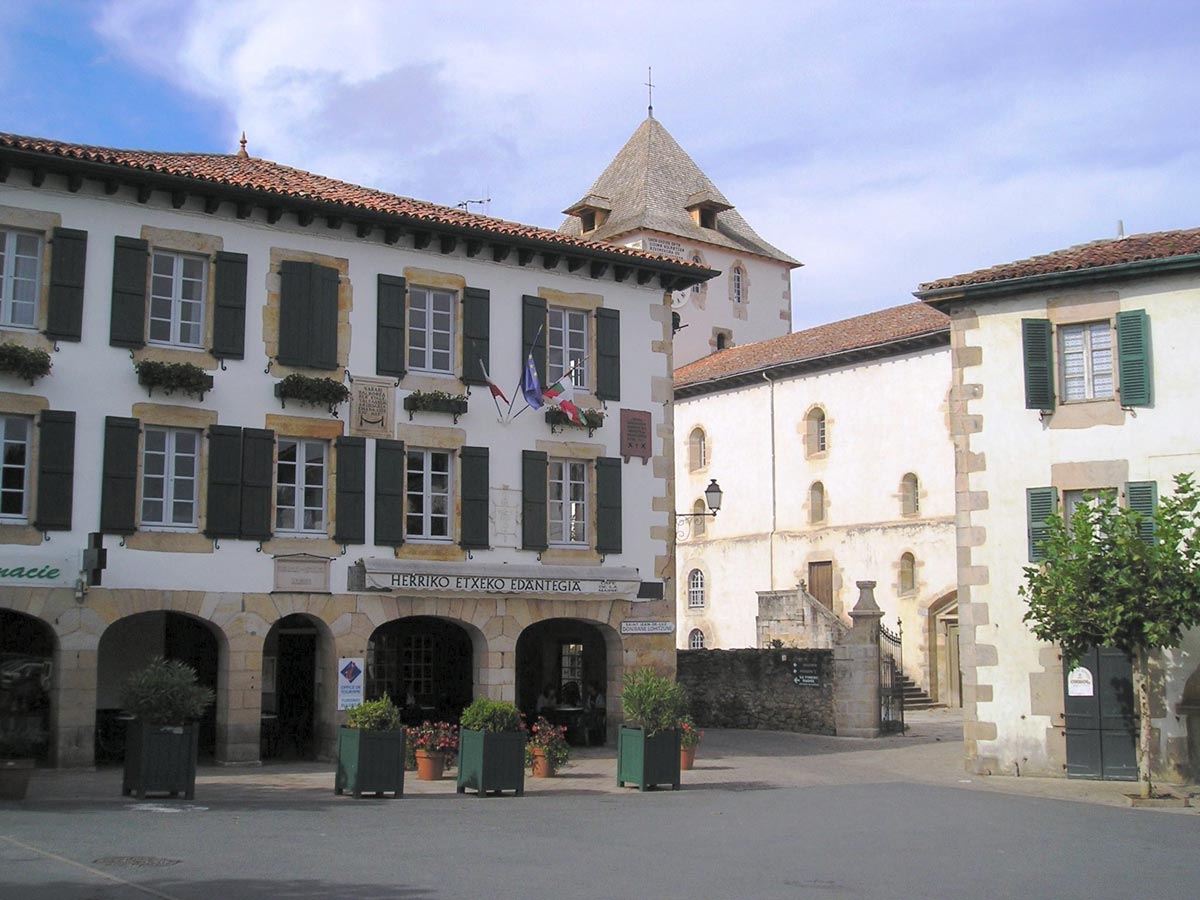
Ideally situated near Spain at the foot of the Rhune, Axuria and Ibanteli peaks, Sare is an authentic Basque village, classified as one of the "most beautiful villages in France", and also known as the "smuggler's village".
The village's central square is occupied by the pelota court, which hosts not only the pelota games but also the farmers' market and all kinds of events.
To the right of the pediment is a reproduction of Picasso's fresco "Guernica", created by artists from the "Axun'arte" association, and the "txalapartas", traditional Basque musical instruments.
In Sare, the Basque language "Euskara" is traditionally spoken.
Sare's motto: "Take your time"...
In Sare, it's good manners and good taste to take one's time. In fact, the village motto is "Saran astia", which means "Sare on a le temps".
It's a philosophy that can also be found on the sundial of the imposing Saint-Martin church.
"Oren guziek dute gizona kolpatzen azkenekoak du hobirat egortzen" could be translated as "All hours hurt man, the last one sends him to the grave".
A village of smugglers
The village of Sare has a 36 km border with its neighbors in the southern Basque country. For many years, the village thrived on "Gauazkolana": night work.
Sare was a mecca for smugglers.
Basques would cross from one side of the border to the other to transport goods: alcohol, tobacco, foodstuffs, animals... They would cross the passes with their espadrilles on their feet so as not to make noise and be spotted by customs officials.
Such a past has given rise to a historic race, the Cross des contrebandiers (Smugglers' Cross).
36 runners take part in this race at the invitation of Sare town council, which asks 18 communes from all over the Basque Country to nominate two champions to represent them in this event.
In general, it takes only 40 minutes for the first runner to cover the 9 km course with his or her 8 kg bundle on his or her back.
The event is always held on the last Sunday in August.
A superb heritage...
Sare offers many points of interest for visitors. In addition to its typical Labourdine Basque houses, the village is home to the church of Saint-Martin and the chapel of Saint-Catherine, the Musée du Gâteau Basque, the Maison Ortillopitz, a traditional house that bears witness to local life, its medieval road (Galtzada), the prehistoric cave of Sare, its washhouses, its oratory, its medieval bridges, its lintels, carved stones on the facades of houses, churches, oratories, pediments... More than 80 lintels have been listed.
The blue pottoks walk
Sare and Ainhoa have joined forces with the 2 border villages of Urdax and Zugarramurdi to create the Xareta territory and offer a walk marked out by blue horses through these 4 villages, enabling visitors to discover the treasures of each.
Urdax is a charming little village of fine Basque buildings and old farmhouses, with a monastery and an ancient mill at its center, well worth a visit.
Zugarramurdi is a famous village in the Basque Country, known as the village of witches, and a visit to the witches' cave will enable you to learn more about this legend.
Dove hunting
It's impossible to say when this tradition began, but it's almost certain that it has always existed in Sare.
At the Etxalar pass, the Basques practice a traditional and rather original dove hunt known as "pantière hunting". This consists of stretching a large net over the pass to capture the pigeons. Men in the tallest trees in the vicinity throw wooden discs into the sky to drive flights of pigeons down to the nets.
This custom begins each year on September 29, Saint Michael's Day, and ends on November 11, Saint Martin's Day.
Each year, an entire week of festivities is dedicated to this activity, with guided tours, cultural events and, above all, the chance to taste pigeon meat in the various restaurants in and around Sare.
Other Sare events include the "rendez-vous des brocanteurs", the "Fêtes de sare", the "Biltzar", a book fair for Basque writers, and the "Fête des Lizarrieta", celebrating the signing of agreements authorizing dove hunting on both sides of the border in the villages of Sare and Etxalar. This festival also showcases old farming tools and ancestral Basque games such as the ancestor of Basque pelota: "bota luze", played face-to-face.
There's also a station where you can catch the famous little train...
A must-see.
Tourist Office
Herriko Etxea - Quartier Bourg
64310 Sare
Tel: 05 59 54 20 14






